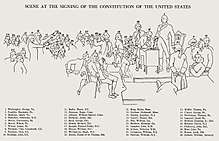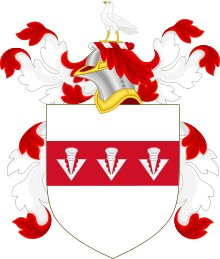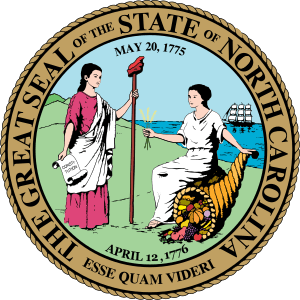Richard Dobbs Spaight
Richard Dobbs Spaight (March 25, 1758 – September 6, 1802) was an American politician, planter, and signer of the United States Constitution, who served as a Democratic-Republican U.S. Representative for North Carolina's 10th congressional district from 1798 to 1801. Spaight previously served as the eighth governor of North Carolina from 1792 to 1795. He ran for the North Carolina State Senate in 1802, and Federalist U.S. Congressman John Stanly campaigned against him as unworthy. Taking offense, Stanly challenged him to a duel on September 5, 1802, in which Stanly shot and mortally wounded Spaight, who died the following day.
Richard Dobbs Spaight | |
|---|---|
 | |
| Member of the U.S. House of Representatives from North Carolina's 10th district | |
| In office December 10, 1798 – March 3, 1801 | |
| Preceded by | Nathan Bryan |
| Succeeded by | John Stanly |
| 8th Governor of North Carolina | |
| In office December 14, 1792 – November 19, 1795 | |
| Preceded by | Alexander Martin |
| Succeeded by | Samuel Ashe |
| Personal details | |
| Born | March 25, 1758 New Bern, North Carolina |
| Died | September 6, 1802 (aged 44) New Bern, North Carolina |
| Resting place | "Clermont," near New Bern, North Carolina 35°04′19.9″N 77°03′17.7″W |
| Political party | Democratic-Republican |
| Other political affiliations | Federalist |
| Spouse(s) | Mary Leach |
| Children | 3 |
| Education | University of Glasgow |
| Military service | |
| Allegiance | |
| Branch/service | North Carolina militia |
| Years of service | 1780 |
| Unit | Aide-de-camp to Major General Richard Caswell |
| Battles/wars | American Revolution |
Biography
Richard Dobbs Spaight was the father of North Carolina governor Richard Dobbs Spaight, Jr., and the grandfather of U.S. Representative Richard Spaight Donnell.
Early life
He was born in New Bern, North Carolina, the son of the Secretary of the Crown in the colony and grand-nephew of North Carolina governor Arthur Dobbs. Orphaned at the age of eight, he was sent to live with his Dobbs relatives at Carrickfergus in northern Ireland and later followed his cousin Richard Dobbs to the University of Glasgow.[1] During the American Revolution Spaight returned to North Carolina, serving as an aide-de-camp to Major General Richard Caswell at the Battle of Camden.
Political career


The General Assembly elected Spaight a delegate to the Confederation Congress between 1782 and 1785; he then served in the North Carolina House of Commons from 1785 to 1787, and was named Speaker of the House. In 1787, he was a delegate to the Philadelphia Convention that drafted the U.S. Constitution, and he signed the document when he was only 29 years old.
Under the State Constitution of 1776, Spaight was nominated for governor in 1787, but was defeated by a majority in the General Assembly; he was nominated for the United States Senate in 1789 and was again defeated. In 1788, he was a member of the state convention which voted not to ratify the Constitution, although Spaight himself supported ratification. On March 24, 1788, he married Mary Leach; Mary had the distinction of being the first lady to dance with George Washington at a ball in Washington’s honor at the Governor's Palace, New Bern, in 1791.
Spaight retired from politics for several years due to ill health; he returned to the state House of Representatives in 1792. Also in 1792, he was elected the first native-born governor of North Carolina,[2] and later re-elected by the General Assembly for two further one-year terms. During his term as governor, sites were chosen for the new state capital of Raleigh and the newly chartered University of North Carolina. Spaight served as chair of the university's board of trustees during his term as governor. He stepped down as governor in 1795, having served the constitutional limit of three one-year terms.
Spaight was elected to the United States House of Representatives in 1798, filling the unexpired term of Nathan Bryan; he was elected to a two-year term in 1799, serving until 1801, and though elected as a Federalist, his views on states rights led him to become associated with the Democratic-Republican party of Thomas Jefferson. He lost his bid for re-election to Congress, but returned to state government, serving in the North Carolina Senate beginning in 1801.
Death and legacy
Spaight died on September 6, 1802, following injuries sustained in a duel with John Stanly, the Federalist congressman who had defeated him in the election of 1800 for the House of Representatives. Spaight is buried at "Clermont," near New Bern, North Carolina. Spaight Street in central Madison, Wisconsin, is named in honor of Richard Spaight. Most of the main streets in downtown Madison are named after signers of the United States Constitution.
Arms
 |
|
References
- Andrew H. Browning, "Richard Dobbs Spaight in Ireland and Scotland: The Education of a North Carolina Founding Father," North Carolina Historical Review 94:127-49.
- "September 1802 – Spaight-Stanly Duel". Retrieved October 23, 2012.
- Bolton's American Armory. Boston: F. W. Faxon Co, 1927
Bibliography
- United States Congress. "Richard Dobbs Spaight (id: S000693)". Biographical Directory of the United States Congress.
- Biographical Directory of the Governors of the United States,, and John Raimo, eds. Westport, CT: Meckler Books, 1978. (ISBN)
- Wheeler, John H. (1880). Sketch of the life of Richard Dobbs Spaight. Retrieved September 20, 2010.
External links
- Richard Dobbs Spaight at Find a Grave
- Richard Dobbs Spaight at The Historical Marker Database (HMdb.org)
- Richard Dobbs Spaight at the National Governors Association
- Richard Dobbs Spaight at The Political Graveyard
- Works by or about Richard Dobbs Spaight at Internet Archive
- Works by or about Richard Dobbs Spaight in libraries (WorldCat catalog)
| Political offices | ||
|---|---|---|
| Preceded by Alexander Martin |
Governor of North Carolina 1792–1795 |
Succeeded by Samuel Ashe |
| U.S. House of Representatives | ||
| Preceded by Nathan Bryan |
Member of the U.S. House of Representatives from North Carolina's 10th congressional district 1798–1801 |
Succeeded by John Stanly |

